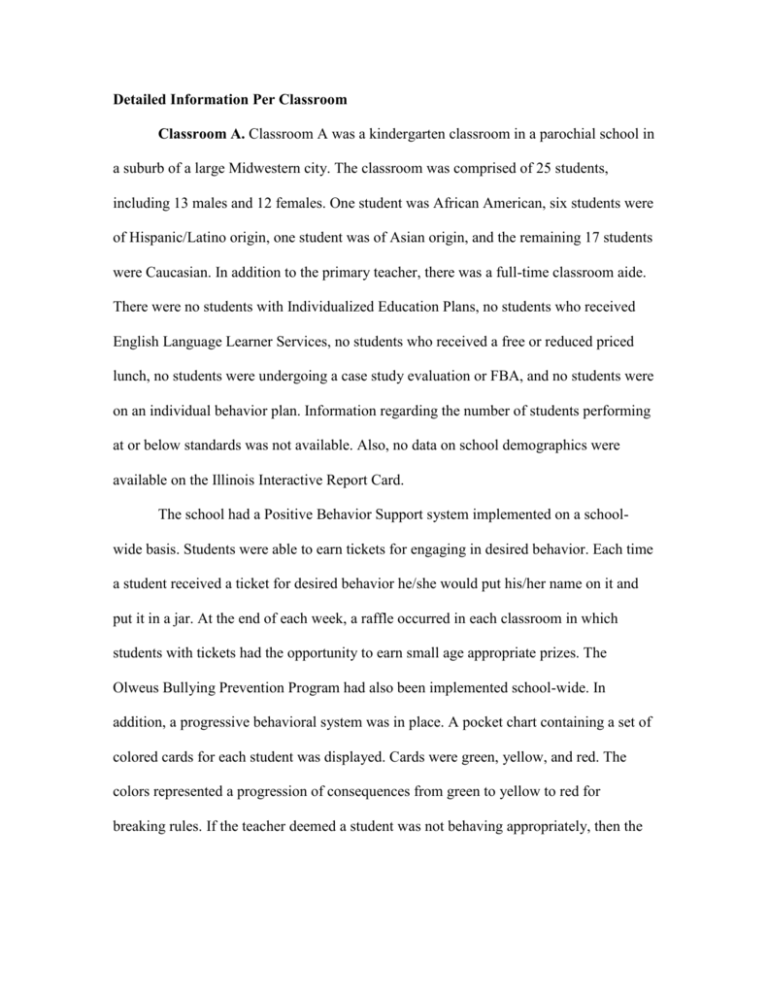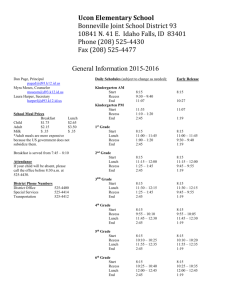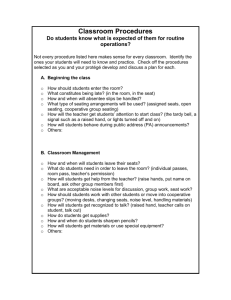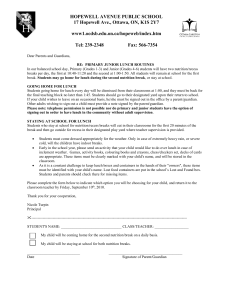Classroom A - American Psychological Association
advertisement

Detailed Information Per Classroom Classroom A. Classroom A was a kindergarten classroom in a parochial school in a suburb of a large Midwestern city. The classroom was comprised of 25 students, including 13 males and 12 females. One student was African American, six students were of Hispanic/Latino origin, one student was of Asian origin, and the remaining 17 students were Caucasian. In addition to the primary teacher, there was a full-time classroom aide. There were no students with Individualized Education Plans, no students who received English Language Learner Services, no students who received a free or reduced priced lunch, no students were undergoing a case study evaluation or FBA, and no students were on an individual behavior plan. Information regarding the number of students performing at or below standards was not available. Also, no data on school demographics were available on the Illinois Interactive Report Card. The school had a Positive Behavior Support system implemented on a schoolwide basis. Students were able to earn tickets for engaging in desired behavior. Each time a student received a ticket for desired behavior he/she would put his/her name on it and put it in a jar. At the end of each week, a raffle occurred in each classroom in which students with tickets had the opportunity to earn small age appropriate prizes. The Olweus Bullying Prevention Program had also been implemented school-wide. In addition, a progressive behavioral system was in place. A pocket chart containing a set of colored cards for each student was displayed. Cards were green, yellow, and red. The colors represented a progression of consequences from green to yellow to red for breaking rules. If the teacher deemed a student was not behaving appropriately, then the student would have to change his/her color. Students had the opportunity to move backwards, from red to yellow, and yellow to green for good behavior. Classroom B. Classroom B was also a kindergarten classroom located in a parochial school in a suburb of a large Midwestern city. The classroom was comprised of 24 students including 14 males and 10 females. One student was African American, two students were of mixed racial backgrounds, one student was of Asian origin, and the remaining 20 students were Caucasian. In addition to the primary teacher, there was a full-time classroom aide. There were no students with Individualized Education Plans, no students who received English Language Learner Services, no students who received a free or reduced priced lunch, no students undergoing a case study evaluation or FBA, and no students with an individual behavior plan. No information regarding the number of students who were performing at or below standards was available. Also, no data on school demographics were available on the Illinois Interactive Report Card. The behavioral supports in Classroom B were equivalent to the behavioral supports in Classroom A. Classroom C. Classroom C was a kindergarten classroom located in a parochial school in a large Midwestern city. The classroom was comprised of 23 students, including 13 males and 10 females. One student was African American, three students were of mixed racial backgrounds, two students were of Asian origin, and the remaining 17 students were Caucasian. In addition to the primary teacher, there was a full-time classroom aide. There were no students with Individualized Education Plans, no students who received English Language Learner Services, no students who received a free or reduced priced lunch; no students were undergoing a case study or an FBA, and no students with an individual behavior plan. Diagnostic Indicators of Basic Early Literacy Skills (DIBELS) were used as a screening tool to assess student academic performance. According to DIBELS data, 20 students were performing at or above standards and three were found to be at-risk. This school was in its second year of implementing Schoolwide Positive Behavior Support. In addition, the same progressive behavioral system involving colored cards was in place as in the aforementioned classrooms. All students who stayed on green could earn a marble for the class; marbles were also used to reinforce desired behavior in the classroom. When the marble jar was filled, the students could earn a sticker, which they would place on their personal folder. No data on school demographics were available on the Illinois Interactive Report Card. Classroom D. Classroom D was a first grade public school classroom located in a suburb of a large Midwestern city. The classroom was comprised of 17 students including nine males and eight females. One student was African American, three students were of mixed racial backgrounds, five students were of Hispanic/Latino origin, two students were Pakistani, and the remaining nine students were Caucasian. One student had an Individualized Education Plan, 11 students received English Language Learner Services, and 12 students received a free or reduced priced lunch. Two students were on individual behavior plans. No students were undergoing a case study or an FBA. According to AIMSweb Oral Reading Fluency data, 15 students were performing at or above standards, while two students were performing below standards. The behavioral supports in place at this school included the Olweus Bullying Prevention Program and the colored card progressive system. Students also had the opportunity to earn classroom money based on behavior throughout the day. If they stayed on green the entire day they could earn classroom money. If they moved to yellow or red they would have to pay their teacher with the classroom money. When caught doing something helpful, they also had the opportunity to earn classroom money. The classroom money could be used at the end of the week to buy various prizes from the classroom store. Schoolwide data available through the Illinois Interactive Report Card indicated the racial composition of this school was as follows: 14.9% White, 2% Black, 67.6% Hispanic/Latino, 14.6% Asian, 0.5% multi-racial and 0.5% American Indian. The percentage of students meeting or exceeding standards on the Illinois Standard Achievement Test (ISAT) was 82.7%. Overall, the school had not met Adequate Yearly Progress (AYP) goals within the last school year. The average student to teacher ratio was 15.5:1 in the district; individual school data were not available. The average class size was approximately 22 students. Finally, 68% of the students attending the school came from homes described as economically disadvantaged. Classroom E. Classroom E was a first grade public school classroom located in a far suburb of a large Midwestern city. At the end of the intervention, the classroom was comprised of 31 students including 16 males and 15 females. Throughout the course of the intervention, two students left the classroom, one female and one male, and another three students, two males and one female joined the classroom. At the end of the intervention, nine students were African American, three were of mixed racial background, 19 were of Hispanic/Latino origin, and one student was Caucasian. Four students in the classroom received special education services through an Individualized Education Program. One student was undergoing a case study evaluation for special education. None of the students received English Language Learner services. Five students in this classroom had behavior contracts that allowed them to earn daily points for positive behavior. Twenty-eight students qualified for a free or reduced priced lunch. Fountas and Pinnell assessments were used to measure of language skills. According to this assessment, ten students were performing at or above standards, eight were at-risk, and 11 were performing below grade level. Behavior management systems already in place included school-wide PBS. Students could earn tickets for displaying desired behaviors. These tickets could be used to purchase entry into school events or to purchase items in the school store each Friday. Finally, a progressive behavioral system, utilizing colored cards, was in place similar to the aforementioned schools. Schoolwide data available through the Illinois Interactive Report Card indicated the racial composition of this school was as follows: 1.3% White, 3.3% Black, 91.6% Hispanic, and 3.8% multi-racial. The percentage of students meeting or exceeding standards on the ISAT was 60.9%. Overall, the school had not met AYP goals within the last school year. The average student to teacher ratio was 20.5:1 in the district; individual school data were not available. The average class size was approximately 24 students. Finally, 83% of the students attending the school come from homes described to be economically disadvantaged. Classroom F. Classroom F was a third grade public school classroom located in a suburb of a large Midwestern city. The classroom was comprised of 24 students including 12 males and 12 females at the start of the intervention. All of the students in this classroom were of Hispanic origin. Midway through the intervention, one male student left the classroom. Four students in the classroom received special education services through an Individualized Education Program. One student in the class received English Language Learner services. At the start of the intervention three students had individual behavior plans, but at the end of the intervention there was only one student with an individual behavior plan. All of the students in this classroom qualified for a free or reduced priced lunch. No student was undergoing a case study or FBA. Markers of Academic Progress (MAP) data were used to assess student performance. According to Fall 2011 data, when 26 students were enrolled in the class, 15 students were performing at or above standards, four were at-risk, and another seven were performing below standards. Behavior management systems already in place included Schoolwide PBS however, students could not earn tickets or tokens for appropriate behavior. Only schoolwide behavioral expectations had been developed. In addition, this classroom had the same progressive behavioral system, which utilized colored cards, as the aforementioned classrooms. Schoolwide data available through the Illinois Interactive Report Card indicated the racial make up of this school was as follows: 17.6% White, 0.3% Black, 76.6% Hispanic, 4.7% Asian, 0.3% American Indian and 0.5% multi-racial. The percentage of students meeting or exceeding standards on the ISAT was 75.8%. Overall, the school had not met AYP goals within the last school year. The average student to teacher ratio was 15.5:1 in the district; school data were not available. The average class size was approximately 25 students. Finally, 75% of the students attending the school came from homes described as economically disadvantaged. Classroom G. Classroom G was a fourth grade parochial school classroom located in a large Midwestern city. The classroom was comprised of 24 students including 15 males and nine females. One student was African American, four students were of mixed racial background, four students were of Asian origin, seven students were of Hispanic/Latino background, and the remaining eight students were Caucasian. Two students in this classroom had an Individualized Education Program. An additional student had been recommended for evaluation at the local public school for significant symptoms associated with Attention Deficit Hyperactive Disorder. None of the students received English Language Learner services. Seven of the students in this classroom qualified for a free or reduced priced lunch. According to AIMSweb Oral Reading Fluency measures, 18 students were performing at or above standards, four were considered at-risk, and two were performing below standards. The same colored card progressive behavioral system was in place, as in the aforementioned classrooms, however, students could not move backwards for displaying appropriate behavior. No data on school demographics were available through the Illinois Interactive Report Card. Classroom H. Classroom H was a fourth grade public school classroom located in a far suburb of a large Midwestern city. The classroom was comprised of 29 students, including 18 males and 11 females. Four students were African American, 24 students were of Hispanic/Latino origin and one student was Caucasian. Over the course of the intervention, one Hispanic male student joined the classroom and one Hispanic male student left the classroom. Four students in this classroom had an Individualized Education Program. At the time the intervention was being implemented, one student was undergoing a case study evaluation for an emotional and behavioral disorder. The same student had an individual behavior plan. After, the intervention was completed, as the result of a full case study, this student was found to be eligible for an Individual Education Program and placement in a classroom for students with emotional and behavioral disorders was recommended. None of the students received English Language Learner services. Twenty-three students qualified for a free or reduced priced lunch. The most recent student performance data available was from the ThinkLink Discovery Education Test, which was completed in the winter of 2011. Based on this data, two students performed below standards and 26 met or exceeded standards in mathematics. In Reading/Language Arts, five students performed below standards while 23 met or exceeded standards. Data was only available for 28 students. The school had implemented PBS. School-wide behavioral expectations had been developed, but the school no longer provided individual tickets to students for good behavior because teachers found this practice to be too cumbersome. Instead, entire classrooms could receive tickets when they were displaying good behavior. Classroom prizes were rewarded according to the number of tickets earned. Schoolwide data available through the Illinois Interactive Report Card indicated the racial composition of this school was as follows: 3.4% White, 13.1% Black, 76% Hispanic, 1.5% Asian, and 6.1% multi-racial. The percentage of students meeting or exceeding standards on the ISAT was 67.6%. Overall, the school had not met AYP goals within the last school year. The average student to teacher ratio was 20.5:1 in the district; individual school data were not available. The average class size was approximately 24 students. Finally, 68% of the students attending the school came from homes described as economically disadvantaged. Mystery Rewards Per Classroom Classroom A The teacher reads a story to class Candy Fruit snack Goldfish crackers Juice box Extra science experiment Eraser Pencil Music of choice during independent work 10 minutes outside recess Out of uniform day The teacher has to wear a silly hat Video after lunch instead of rest and read Sticker for the class Pajama day Lunch in the class with a movie Charger chip for the class Classroom B The teacher reads a story to class Candy Fruit snack Goldfish crackers Juice box Extra science experiment Eraser Pencil Music of choice during independent work 10 minutes outside recess Out of uniform day The teacher has to wear a silly hat Video after lunch instead of rest and read Sticker for the class Pajama day Lunch in the class with a movie Charger chip for the class Show and share Classroom C The teacher reads a story Juice box after recess Extra science experiment Eraser Pencil 5 minutes extra outside recess Teachers have to wear a silly hat Watch video after lunch instead of rest Sticker Bonus marble for everyone in the class One extra computer class Classroom D Candy Fruit snack Goldfish crackers Eraser Pencil Music of choice during independent work 10 minutes free time 5 minutes free time The teacher has to wear a silly hat Video during lunch Pajama day 10 minutes time to play a game in class Extra $0.50 to spend in the class store Classroom E Homework pass 10 minutes game time 5 minutes extra recess 5 minutes in the computer lab to play a game Goldfish crackers Rice crispy treat Candy Paw for the class Hat day Pencil Sticker Eraser Extra art time Teacher reads a story Classroom F Teacher reads a story Students can bring a stuffed animal to class Candy Rice crispy treat Fruit snack Eraser Pencil Pencil sharpener Homework pass Music during work time 10 minutes free time 5 minutes free time Hat day Watch a video Pajama Day Movie during recess/lunch Smartboard game during recess Classroom G Homework pass Candy Eraser Pencil Mini notepad Hat day Watch a video for 20 minutes in class Music of choice during independent work 5 minutes extra recess 10 minutes free time Classroom H Homework pass 10 minutes free time 5 minutes extra recess Lunch in the classroom with a video Pajama day in the class Music of choice during independent work Juice box Candy Hat day Pencil Sticker Eraser







